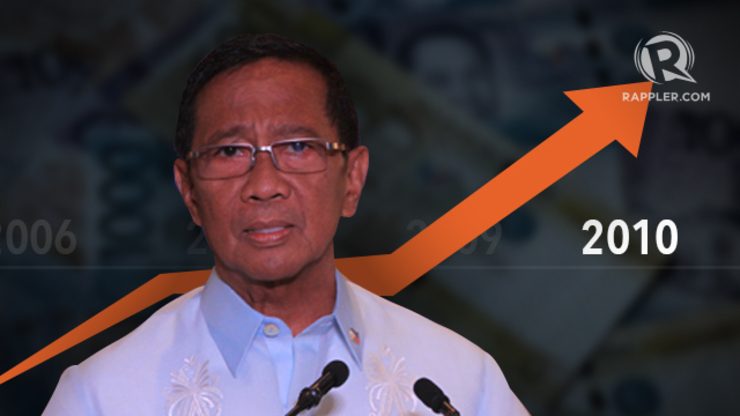SUMMARY
This is AI generated summarization, which may have errors. For context, always refer to the full article.

MANILA, Philippines – The most glaring increase in the wealth of Jejomar Binay was in 2010, the year he won as vice president.
Binay’s Statements of Assets, Liabilities and Net Worth (SALNs) indicate that since he assumed public office – first as mayor then as vice president – his net worth has been increasing.
Binay’s SALNs from 1988 to 2013 – copies of which were released to the media – show that with the exception of 2011, the Vice President is becoming increasingly wealthy. The only exception in his steadily increasing wealth was in 2011 when his net worth dropped by more than P200,000.
The most noticeable rise in his SALNs is in his 2010 declaration, which shows that his net worth soared by more than 13 million – the highest increase among other declarations – reflecting a 31% increase from 2009.
A close look at his 2010 SALN shows that the big jump in the value of his personal assets contributed greatly to the increase of his net worth. While the value of his real assets remained the same and the value of liabilities even increased, the worth of his personal assets increased by almost 50%.
See Binay’s 2009 and 2010 SALNs below:
The biggest contributor in the increase in Binay’s personal assets in 2010 is his cash assets, which jumped by more than 2,000% from just around P806,000 in 2009 to a huge P17 million a year after.
The amount of his cash continued to increase after 2010. His succeeding SALNs reveal the following cash values:
- 2011 SALN – P21,339,723.79
- 2012 SALN – P22,579,259
- 2013 SALN – P28,783,088
Another big rise in Binay’s 2010 personal assets is visible in his receivables, which increased by almost 1,000%.
Surprisingly, since winning the vice presidency, Binay’s SALNs show that his only sources of income are his salary in public office and his earnings from the Blooms and Bouquet flower business of his wife, Elenita Binay.
The Binay camp earlier explained that he divested from JCB Farms, a piggery business based in Rosario, Batangas which he acquired in 1994, as well as from investments in shares of stocks after winning the vice presidency in 2010.
Campaign funds as extra income?
The Binay camp has said that the excess 2010 campaign contributions for the Vice President was reflected in his SALN declaration, and could be a factor for the huge increase in his cash assets.
In 2010, Binay also reported P13.541 million in excess campaign contributions. He was able to gather P231.48 million in total contributions, but used only P217.938 million for his campaign.
In an ABS-CBN report, Binay’s lawyer Martin Subido revealed that the excess campaign contributions were indeed declared in Binay’s SALN.
But Cavite Governor Juanito Victor Remulla, Binay’s spokesman for political affairs, explained they have yet to clarify if excess campaign donations are considered income and are thus taxable. (READ: From P2.5M to P60M: How VP Binay amassed his wealth)
He added that the Vice President is willing to submit proper documents if it is indeed considered as such. It is unclear whether Binay paid taxes for income derived from the campaign contributions because his camp did not provide the media with copies of his income tax returns (ITR) for 2009 and 2010. The latest ITR copy they provided was for year 2008.
Taxable or not?
Section 13 of Republic Act 7166 states that campaign contributions, whether in cash or in kind, shall not be subject to payment of any tax – provided they are duly reported to the Commission on Elections (Comelec). The law, however, does not differentiate between utilized and unused campaign funds.
The Bureau of Internal Revenue (BIR), however, provides a clearer position on the issue via Revenue Regulation 7-2011. Section 2 of this regulation states:
Unutilized/excess campaign funds, that is, campaign contributions net of the candidate’s campaign expenditures, shall be considered as subject to income tax, and as such, must be included in the candidate’s taxable income as stated in his/her Income Tax Return (ITR) filed for the subject taxable year.
The regulation also states that if a candidate fails to file with Comelec the appropriate Statement of Expenditures, the entire amount of campaign contributions – whether utilized or not – shall be considered as directly subject to income tax.
The Binay camp released his SALNs to the media following charges of corruption against him and his family. A plunder case was filed against him in July over the alleged overpriced Makati City building. A Senate investigation also revealed that he allegedly earned 13% in kickbacks from the city’s projects. – Rappler.com
Philippine currency image from Shutterstock
Add a comment
How does this make you feel?
There are no comments yet. Add your comment to start the conversation.